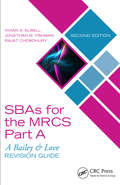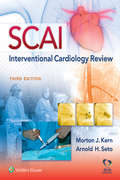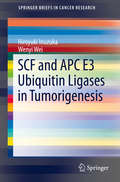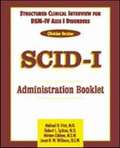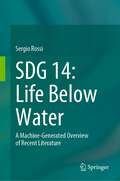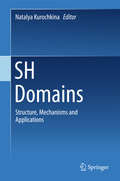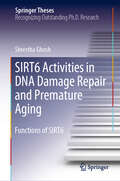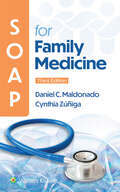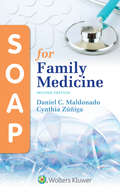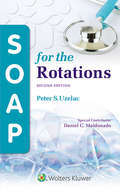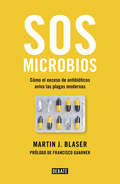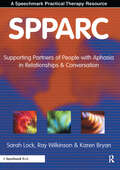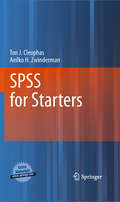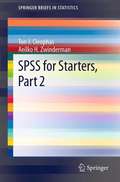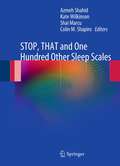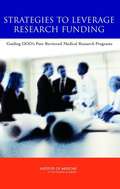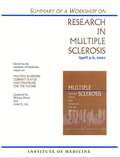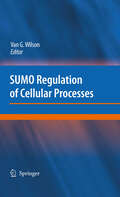- Table View
- List View
SBAs for the MRCS Part A: A Bailey & Love Revision Guide
by Rajat Chowdhury Jonathan M. Fishman Vivian A. ElwellThe four Surgical Royal Colleges have recently received approval from the GMC to make changes to the MRCS Part A Examination. The second edition of this popular book,SBAs and EMQs for the MRCS Part A is an invaluable guide to sitting and passing the new MRCS examination.There is an increased emphasis on Anatomy and Basic Sciences,which now account for 60% of the exam. College-approved,systematic and coherent questions for all the main systems are included, providing comprehensive coverage of the curriculum. The Question and Answer format, including many more Single Best Answers aids revision.Expanded to reflect the new 2017curriculum
SCAI Interventional Cardiology Review
by Morton J. KernWhether you’re studying for the interventional cardiology board exam, preparing for recertification, or simply want a concise review of the field, SCAI Interventional Cardiology Review, 3rd Edition, brings you up to date with recent changes in interventional cardiology while also preparing you for exam success. Written by global experts who are Society for Cardiovascular Angiography and Interventions (SCAI) members and leaders, coverage includes all topics on the exam, with the addition of new review questions, new topics, and revised information throughout.
SCF and APC E3 Ubiquitin Ligases in Tumorigenesis
by Hiroyuki Inuzuka Wenyi WeiThis SpringerBrief explores the physiological roles of Skp1-Cullin1-F-box Complex (SCF) and Anaphase Promoting Complex (APC) in normal cells and in tumor formation. These two related, multi-subunit E3 ubiquitin ligase enzymes, APC and SCF are thought to be the major driving forces governing proper cell cycle progression Defective cell cycle regulation leads to genomic instability and ultimately, cancer development. Selective degradation of key cell cycle regulators by the ubiquitin-proteasome system has been proven to be a major regulatory mechanism for ensuring ordered and coordinated cell cycle progression. The SCF and APC E3 ligases have been characterized to play pivotal roles in regulating the cell cycle progression by timely degrading various critical cell cycle regulators. This Brief reviews recent studies that have shown that deregulation of signaling pathways in which the two ubiquitin ligases are involved causes aberrant cell cycle regulation, in turn leading to tumorigenesis The text also discusses how SCF and APC may present promising therapeutic targets to treat various cancers.
SCID-I Administration Booklet: Structured Clinical Interview for DSM-IV Axis I Disorders. Clinician Version
by Michael B. First Miriam Gibbon Robert L. Spitzer Janet B. WilliamsThe Administration Booklet contains interview questions and DSM-IV diagnostic criteria. It is designed to be used with the Scoresheet during a 45- to 90-minute session and is tabbed to help the clinician move from one section to another.
SCN2A-Related Disorders (Elements in Genetics in Epilepsy)
by Megan Abbott Kevin J. Bender Andreas Brunklaus Scott Demarest Shawn Egan Isabel Haviland Jennifer A. Kearney Heather E. Olson Stephan J. Sanders Christina SanInocencio Joseph Symonds Christopher H. Thompson Leah Schust MyersSCN2A encodes a voltage-gated sodium channel (designated NaV1.2) vital for generating neuronal action potentials. Pathogenic SCN2A variants are associated with a diverse array of neurodevelopmental disorders featuring neonatal or infantile onset epilepsy, developmental delay, autism, intellectual disability and movement disorders. SCN2A is a high confidence risk gene for autism spectrum disorder and a commonly discovered cause of neonatal onset epilepsy. This remarkable clinical heterogeneity is mirrored by extensive allelic heterogeneity and complex genotype-phenotype relationships partially explained by divergent functional consequences of pathogenic variants. Emerging therapeutic strategies targeted to specific patterns of NaV1.2 dysfunction offer hope to improving the lives of individuals affected by SCN2A-related disorders. This Element provides a review of the clinical features, genetic basis, pathophysiology, pharmacology and treatment of these genetic conditions authored by leading experts in the field and accompanied by perspectives shared by affected families. This title is also available as Open Access on Cambridge Core.
SDG 14: A Machine-Generated Overview of Recent Literature
by Sergio RossiThis book focuses, in seven chapters, on the perspectives and solutions that different research groups offer to try to address problems related to SDG 14: Life Below Water. The different objectives developed in SDG 14 are treated independently, with an attempt to give a global vision of the issues. The mechanism used to select the book's content was through an Artificial Intelligence program, choosing articles related to the topics by means of keywords. The program selected those articles, and those that were not related to the topic or did not focus on SDG 14 were discarded by a subject matter expert. Obviously, the selection was partial and the entire subject is not covered, but the final product gives a very solid idea of how to orient ourselves to delve deeper into the topic of SDG 14 using published chapters and articles. The AI program itself selected the text of these contributions to show the progress in different topics related to SDG 14. This mode of operation will allow specialists (and non-specialists) to collect useful information for their specific research purposes in a short period of time. At a time when information is essential in order to move quickly by providing concrete answers to complex problems, this type of approach will become essential for researchers, especially for a subject as vast as SDG 14.
SH Domains
by Natalya KurochkinaThis book covers structure, function, and important roles of the SH domains, structure-function relationships, the versatile nature of their action, mechanisms of aggregation, specificity of interactions, impact of mutations on protein functional dysregulation, and cell signaling. Their involvement in various cellular processes such as migration, invasiveness, actin reorganization, shaping spines, determination of the morphology assembly of fibrils, and mechanotransduction makes these molecules attractive drug targets. Substrates, inhibitors and activators of PTKs present a wide variety of therapeutic agents in the context of delivering treatments for numerous pathologies. The new emerging field of stem cell therapies and design of biomaterials for treatments relies on the directed regulation of stem cell growth, differentiation and morphology, as well as the production of biomimetic scaffolds that respond to programmed signals. Advances in deciphering the mechanisms of action of these important molecules will lead to the implementation and success of their vital applications.
SIR - Modell durch eine neue Dichte unterstützt: Handlungsdokument für ein angepasstes COVID – Management
by Marcus HellwigDas durch eine neue Dichte unterstützte SIR – Modell und dessen Derivate erhalten einen statistischen Datenhintergrund aus Häufigkeitsverteilungen, aus deren Parameterwerten über die neue Dichteverteilung auf eine qualitätsorientierte Wahrscheinlichkeit des jeweiligen Infektionsprozesses und seiner Zukunft geschlossen werden kann. Dadurch erhält das COVID - Management eine funktionsgemäße modellhafte Grundlage zur vorbeugenden Steuerung der Komponenten Zeitplanung, Kostenentwicklung, Qualitätsmanagement und Personal- und Materialeinsatz.
SIRT6 Activities in DNA Damage Repair and Premature Aging: Functions of SIRT6 (Springer Theses)
by Shrestha GhoshThis book illustrates the activities of mammalian sirtuin SIRT6 in connection with DNA damage repair and premature aging. It mainly presents research on the nuclear lamin A, notably the upregulation of p53 and acetylation etc. Taken together, these studies reveal the various regulatory roles of SIRT6, which are of substantial biological relevance in DNA damage repair, aging and longevity, and can have significant implications in devising therapeutic strategies to combat age-associated pathologies. Given its scope, the book offers a valuable resource for students and researchers in the fields of genetics, cell biology, molecular biology etc.
SOAP for Family Medicine
by Daniel Maldonado Cynthia ZunigaOffering step-by-step guidance on how to properly document patient care, this updated Second Edition presents 90 of the most common clinical problems encountered on the wards and clinics in an easy-to-read, two-page layout using the familiar "SOAP" note format. Emphasizing the patient’s clinical problem, not the diagnosis, this pocket-sized quick reference teaches both clinical reasoning and documentation skills and is ideal for use by medical students, PAs, and NPs during the Family Medicine rotation. The Introduction offers templates, tips, and guidelines for writing SOAP notes. A portable, pocket-sized format with at-a-glance, two-page layouts makes practical information quickly accessible. The SOAP approach helps students figure out where to start, while improving communication between physicians and ensuring accurate documentation.
SOAP for Family Medicine (Soap Ser.)
by Daniel MaldonadoOffering step-by-step guidance on how to properly document patient care, this updated Second Edition presents 90 of the most common clinical problems encountered on the wards and clinics in an easy-to-read, two-page layout using the familiar "SOAP" note format. Emphasizing the patient’s clinical problem, not the diagnosis, this pocket-sized quick reference teaches both clinical reasoning and documentation skills and is ideal for use by medical students, Pas, and NPs during the Family Medicine rotation.
SOAP for the Rotations
by Peter S. UzelacIdeal for medical students, PAs and NPs, this pocket-sized quick reference helps students hone the clinical reasoning and documentation skills needed for effective practice in internal medicine, pediatrics, OB/GYN, surgery, emergency medicine, and psychiatry. This updated edition offers step-by-step guidance on how to properly document patient care as it addresses the most common clinical problems encountered on the wards and clinics. Emphasizing the patient’s clinical problem, not the diagnosis, the book’s at-a-glance, two-page layout uses the familiar SOAP note format.
SOS microbios: Cómo nuestro abuso de los antibióticos aviva las plagas modernas
by Martin J. Blaser¿Cómo está el consumo abusivo de antibióticos avivando la aparición y la propagación de plagas modernas? En este libro, el doctor Blaser nos invita a explorar el enmarañado universo del microbioma humano, en el que las bacterias y las células humanas llevan cientos de miles de años coexistiendo en una armoniosa simbiosis responsable del equilibrio y la salud de nuestro cuerpo. Hoy, nuestra desmesurada dependencia de los antibióticos está comprometiendo este Edén imperceptible al ojo humano. El abuso de estos medicamentos amenaza con la extinción de nuestros irremplazables microbios, situación que conlleva gravísimas consecuencias para la salud: obesidad, asma, diabetes e incluso la aparición de determinados tipos de cáncer. A lo largo de estas páginas, el doctor Blaser nos presenta los diversos laboratorios y estudios que investigan estas cuestiones y nos convierte en testigos de sus inquietantes hallazgos. SOS microbios es un análisis de extrema urgencia de los efectos perjudiciales del abuso de antibióticos que no solo aporta un gran número de pruebas irrefutables, sino que también brinda consejos para evitar problemas de salud nefastos para el futuro. Reseñas:«El peso de los datos en que se sustentan las advertencias del doctor Blaser sobre los antibióticos es abrumador.»The New York Times «A diferencia de algunos libros sobre medicina y microbios, el doctor Blaser no despierta temores a enfermedades exóticas o superbacterias pandémicas resistentes a todos los medicamentos conocidos. Se centra en una preocupación más simple pero más profunda: el daño que la vida moderna inflige en la gran cantidad de microbios que, incluso las personas sanas, albergamos en todo momento.»The Wall Street Journal «Accesible y desafiante, proporciona un estímulo con el que sondear el dogma existente.»Science «¿Por qué tienes sobrepeso? ¿Por qué tu hijo tiene asma? Según el doctor Martin J. Blaser, todo ello se debe a que a nuestros cuerpos les faltan bacterias imprescindibles. Garantizo a los lectores que después de leer este libro estarán de acuerdo con él.»Laurie Garrett, premio Pulitzer y autora de Ebola. Story of an Outbreak «Un impactante análisis de una de las formas de vida dominantes del planeta Tierra.»Publishers Weekly «Una obra maestra sobre salud preventiva.»Booklist
SPIONs as Nano-Theranostics Agents
by Atefeh Zarepour Ali Zarrabi Arezoo KhosraviThis Brief introduces SuperParamagnetic Iron Oxide Nanoparticles (SPIONs), the different synthesis approaches, their applications in the field of diagnostics and treatment and finally as theranostic agents in cancer.
SPPARC: Supporting Partners of People with Aphasia in Relationships and Conversation
by Karen Bryan Ray Wilkinson Sarah Lock"SPPARC" highlights the importance of working with partners in order to create real life change both for partners and for people with aphasia. "The SPPARC" pack consists of a manual, CD Rom and DVD and provides: practical resources to run, support and conversation training programmes either for groups of partners or for the partner and the person with aphasia together as a couple; conversation assessment and treatment materials, photocopiable and printable (from the CD Rom) activities and handouts, as well as an introduction to conversational analysis; and, a DVD with 27 extracts of everyday conversations between several people with aphasia and their partners, which can be used as a resource both for assessing everyday conversation and for facilitating change.Theoretically validated through the 'Coping with Communicating' research project from University College London, "SPPARC" goes beyond the theory and provides a complete resource of clinically effective tools to work with people with aphasia and their communication partners.
SPSS for Starters
by Aeilko H. Zwinderman Ton J. CleophasThis small book contains all statistical tests that are relevant for starters on SPSS. Each test is explained using a data example from clinical practice, including every step in SPSS and the main tables of results with an accompanying text with interpretations of the results and hints convenient for data reporting, i.e., scientific clinical articles and poster presentations.. In order to facilitate the use of this cookbook the data files of the examples are made available by the publisher on the Internet. For investigators who wish to perform their own data analyses from the very start the book can be used as a step-by-step guideline. They can enter their separate data or enter their entire data file, e.g., from Excel, simply by opening an Excel file in SPSS. SPSS statistical software is a user-friendly statistical software with many help and tutor pages. However, for the novices on SPSS an even more basic approach is welcome. The book is meant for this very purpose, and can be used without the help of a teacher. The authors are well-aware that this cookbook contains a minimal amount of text and a maximal technical details, but we believe that this property will not refrain students from mastering the SPSS software systematic, and that, instead, it will even be a help to that aim. Yet, we recommend that it be used together with the textbook "Statistics Applied to Clinical Trials" by Cleophas et al, 4th Edition, 2009, Springer Dordrecht.
SPSS for Starters, Part 2
by Aeilko H. Zwinderman Ton J. CleophasThe first part of this title contained all statistical tests that are relevant for starters on SPSS, and included standard parametric and non-parametric tests for continuous and binary variables, regression methods, trend tests, and reliability and validity assessments of diagnostic tests. The current part 2 of this title reviews multistep methods, multivariate models, assessments of missing data, performance of diagnostic tests, meta-regression, Poisson regression, confounding and interaction, and survival analyses using log tests and segmented time-dependent Cox regression. Methods for assessing non linear models, data seasonality, distribution free methods, including Monte Carlo methods and artificial intelligence, and robust tests are also covered. Each method of testing is explained using a data example from clinical practice,including every step in SPSS, and a text with interpretations of the results and hints convenient for data reporting. In order to facilitate the use of this cookbook the data files of the examples is made available by the editor through extras.springer.com. Both part 1 and 2 of this title contain a minima amount of text and maximal technical details, but we believe that this property will not refrain students from mastering the SPSS software systematics, and that, instead, it will be a help to that aim. Yet, we recommend that it will used together with the textbook "Statistics Applied to Clinical Trials" (5th edition, Springer, Dordrecht 2012) and the e-books "Statistics on a Pocket Calculator Part 1 and 2 (Springer, Dordrecht, 2011 and 2012) from the same authors.
SPSS for Starters, Part 2 (SpringerBriefs in Statistics)
by Aeilko H. Zwinderman Ton J. CleophasThe first part of this title contained all statistical tests that are relevant for starters on SPSS, and included standard parametric and non-parametric tests for continuous and binary variables, regression methods, trend tests, and reliability and validity assessments of diagnostic tests. The current part 2 of this title reviews multistep methods, multivariate models, assessments of missing data, performance of diagnostic tests, meta-regression, Poisson regression, confounding and interaction, and survival analyses using log tests and segmented time-dependent Cox regression. Methods for assessing non linear models, data seasonality, distribution free methods, including Monte Carlo methods and artificial intelligence, and robust tests are also covered. Each method of testing is explained using a data example from clinical practice,including every step in SPSS, and a text with interpretations of the results and hints convenient for data reporting. In order to facilitate the use of this cookbook the data files of the examples is made available by the editor through extras.springer.com. Both part 1 and 2 of this title contain a minima amount of text and maximal technical details, but we believe that this property will not refrain students from mastering the SPSS software systematics, and that, instead, it will be a help to that aim. Yet, we recommend that it will used together with the textbook "Statistics Applied to Clinical Trials" (5th edition, Springer, Dordrecht 2012) and the e-books "Statistics on a Pocket Calculator Part 1 and 2 (Springer, Dordrecht, 2011 and 2012) from the same authors.
STAT Inhibitors in Cancer
by Alister C. WardThis volume, which includes contributions from leading scientists and clinicians in the field, provides definitive, state-of-the-art information on STAT inhibitors in a biological and clinical context. It gives an overview of the biology of the STAT family of transcription factors and their role in cancer etiology. Additionally, it describes the raft of therapeutic approaches being used to inhibit STATs in the context of various cancers, covering the full spectrum of therapeutic approaches to inhibiting STATs, and presenting emerging data from clinical trials.
STEMI vs. “FEMI”: A Real STEMI or a Fake STEMI
by Henry K. SiuPublisher's Note: Products purchased from 3rd Party sellers are not guaranteed by the Publisher for quality, authenticity, or access to any online entitlements included with the product. For patients presenting with chest discomfort or other suspicious cardiac symptoms, distinguishing between ST-elevation myocardial infarction (STEMI) and “fake ST elevation MI” (“FEMI”) is of utmost importance. Although efficient and accurate ECG interpretation is vital, it is often difficult in nuanced clinical situations that contribute to diagnostic uncertainty. Now you can sharpen your clinical skills in this critical area with a unique resource that offers real-world practice in identifying actual STEMI events vs. FEMI.
STOP, THAT and One Hundred Other Sleep Scales
by Shai Marcu Azmeh Shahid Kate Wilkinson Colin M ShapiroThere are at least four reasons why a sleep clinician should be familiar with rating scales that evaluate different facets of sleep. First, the use of scales facilitates a quick and accurate assessment of a complex clinical problem. In three or four minutes (the time to review ten standard scales), a clinician can come to a broad understanding of the patient in question. For example, a selection of scales might indicate that an individual is sleepy but not fatigued; lacking alertness with no insomnia; presenting with no symptoms of narcolepsy or restless legs but showing clear features of apnea; exhibiting depression and a history of significant alcohol problems. This information can be used to direct the consultation to those issues perceived as most relevant, and can even provide a springboard for explaining the benefits of certain treatment approaches or the potential corollaries of allowing the status quo to continue. Second, rating scales can provide a clinician with an enhanced vocabulary or language, improving his or her understanding of each patient. In the case of the sleep specialist, a scale can help him to distinguish fatigue from sleepiness in a patient, or elucidate the differences between sleepiness and alertness (which is not merely the inverse of the former). Sleep scales are developed by researchers and clinicians who have spent years in their field, carefully honing their preferred methods for assessing certain brain states or characteristic features of a condition. Thus, scales provide clinicians with a repertoire of questions, allowing them to draw upon the extensive experience of their colleagues when attempting to tease apart nuanced problems. Third, some scales are helpful for tracking a patient's progress. A particular patient may not remember how alert he felt on a series of different stimulant medications. Scale assessments administered periodically over the course of treatment provide an objective record of the intervention, allowing the clinician to examine and possibly reassess her approach to the patient. Finally, for individuals conducting a double-blind crossover trial or a straightforward clinical practice audit, those who are interested in research will find that their own clinics become a source of great discovery. Scales provide standardized measures that allow colleagues across cities and countries to coordinate their practices. They enable the replication of previous studies and facilitate the organization and dissemination of new research in a way that is accessible and rapid. As the emphasis placed on evidence-based care grows, a clinician's ability to assess his or her own practice and its relation to the wider medical community becomes invaluable. Scales make this kind of standardization possible, just as they enable the research efforts that help to formulate those standards. The majority of Rating Scales in Sleep and Sleep Disorders: 100 Scales for Clinical Practice is devoted to briefly discussing individual scales. When possible, an example of the scale is provided so that readers may gain a sense of the instrument's content. Groundbreaking and the first of its kind to conceptualize and organize the essential scales used in sleep medicine, Rating Scales in Sleep and Sleep Disorders: 100 Scales for Clinical Practice is an invaluable resource for all clinicians and researchers interested in sleep disorders.
STRATEGIES TO LEVERAGE RESEARCH FUNDING: Guiding DOD's Peer Reviewed Medical Research Programs
by Committee on Alternative Funding Strategies for DOD's Peer Reviewed Medical Research ProgramsSince 1992 the Department of Defense (DOD), through the U. S. Army Medical Research and Material Command, has received congressionally earmarked appropriations for programs of biomedical research on prostate, breast, and ovarian cancer; neurofibromatosis; tuberous sclerosis; and other health problems. Appropriations for these Congressionally Directed Medical Research Programs are used to support peer reviewed extramural research project, training, and infrastructure grants. Congress has become concerned about funding increases for these programs given current demands on the military budget. At the request of Congress, the Institute of Medicine (IOM) examined possibilities of augmenting program funding from alternative sources. The resulting IOM book, Strategies to Leverage Research Funding: Guiding DOD’s Peer Reviewed Medical Research Programs, focuses on nonfederal and private sector contributions that could extend the appropriated funds without biasing the peer review project selection process.
SUBMARINE EXPOSURE GUIDANCE LEVELS FOR SELECTED HYDROFLUOROCARBONS: HFC-236fa, HFC-23, and HFC-404a
by Subcommittee on Exposure Guidance Levels for Selected HydrofluorocarbonsThe National Academies Press (NAP)--publisher for the National Academies--publishes more than 200 books a year offering the most authoritative views, definitive information, and groundbreaking recommendations on a wide range of topics in science, engineering, and health. Our books are unique in that they are authored by the nation's leading experts in every scientific field.
SUMMARY OF A WORKSHOP ON RESEARCH IN MULTIPLE SCLEROSIS April 5-6, 2001
by Board On Neuroscience Behavioral HealthThe National Academies Press (NAP)--publisher for the National Academies--publishes more than 200 books a year offering the most authoritative views, definitive information, and groundbreaking recommendations on a wide range of topics in science, engineering, and health. Our books are unique in that they are authored by the nation's leading experts in every scientific field.
SUMO Regulation of Cellular Processes
by G. WilsonOver a decade ago, a small cellular protein of 12 kDa, with 18% homology to the well-known ubiquitin protein, was co-discovered and termed Small Ubiquitin-like Modifier, or SUMO. Sumoylation is a post-translational modification that utilizes SUMO as the modifier group covalently attached to target substrates. This state-of-the art review on the sumoylation system deals with protein modification as it pertains to regulation of diverse cellular functions. Each chapter has been written by a leading researcher and covers the role of sumoylation in fundamental biochemical activities (transcription, RNA processing, chromatin remodelling, DNA repair, nucleocytoplasmic transport, ion channel regulation, and metabolic pathways). The text also examines the part sumoylation plays in critical cellular processes such as mitosis, meiosis, differentiation, senescence, and apoptosis. Lastly, the emerging role of sumoylation in specific diseases, including cancer and diabetes as well as neurodegenerative ones, is explored with an emphasis on defining molecular mechanisms that may provide new targets for treatment or prevention. While SUMO was discovered more than 10 years ago, this is still a relatively young field, and much remains to be discovered about the biochemical and biological properties of this modification system. In just the last few years, it has become clear that sumoylation modifies hundreds of cellular proteins, and there has been increased appreciation for the breadth of cellular functions that are impacted by this post-translational modification.
